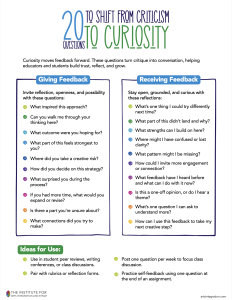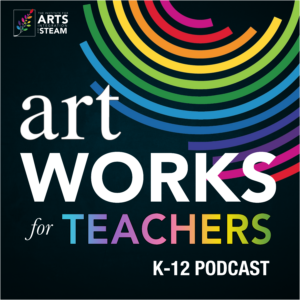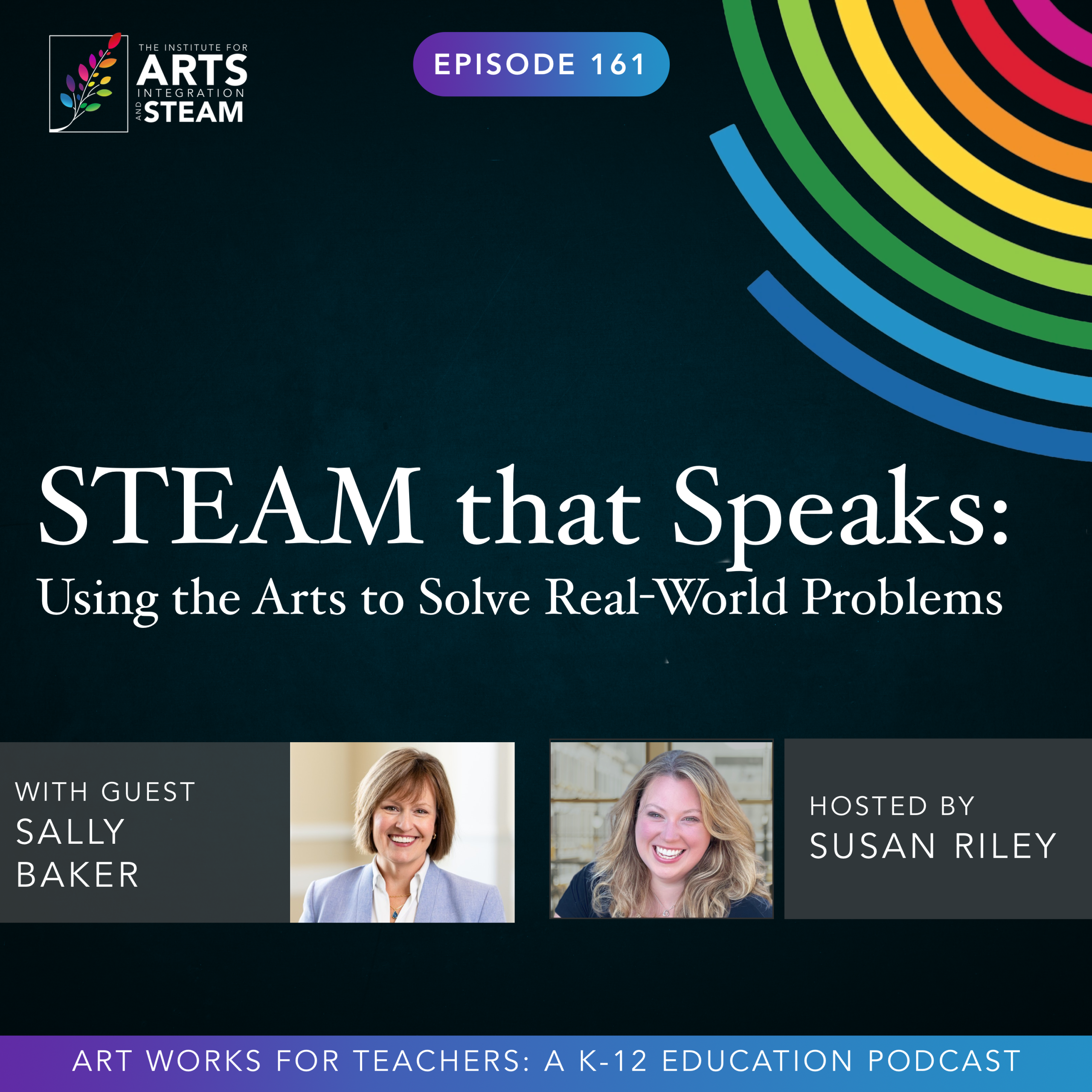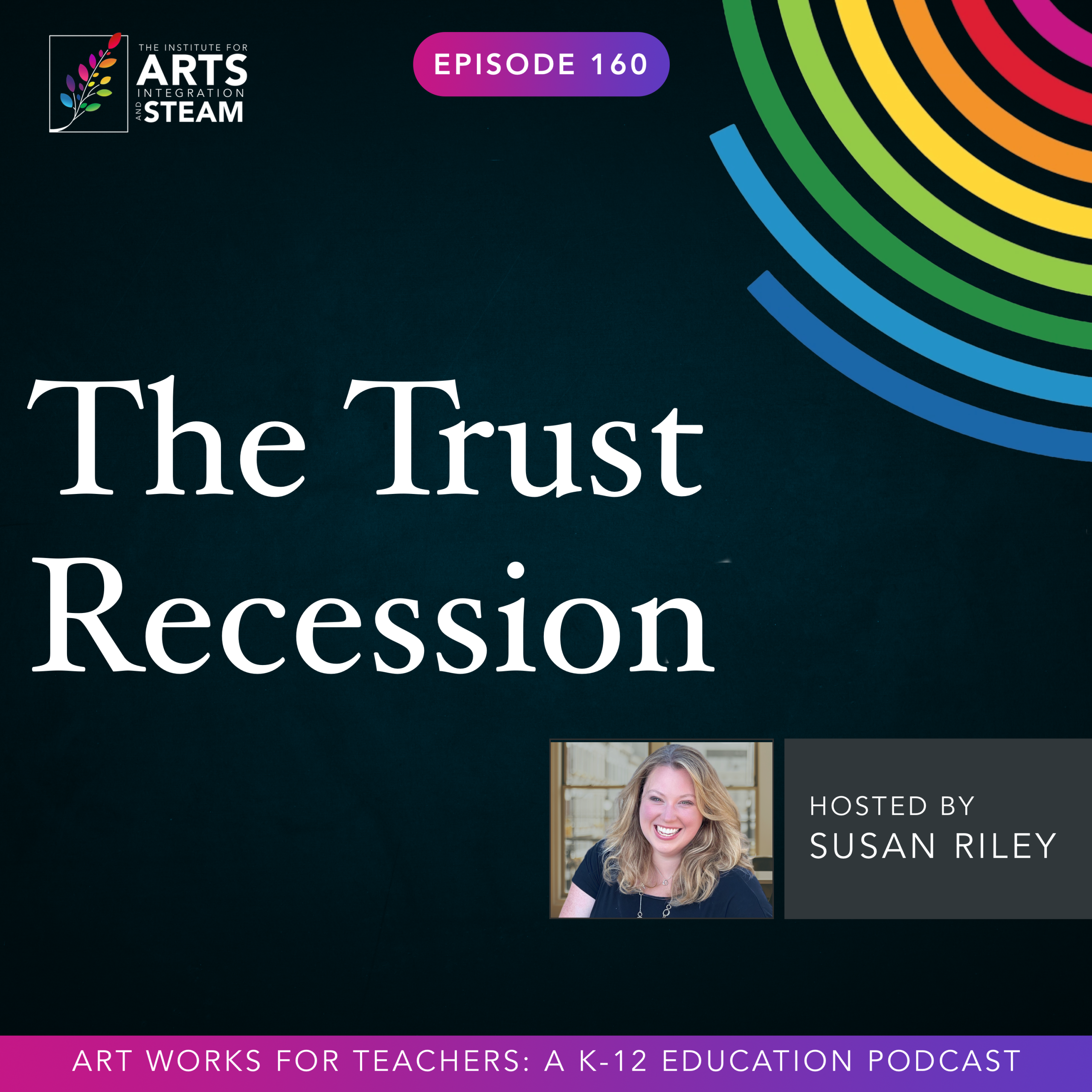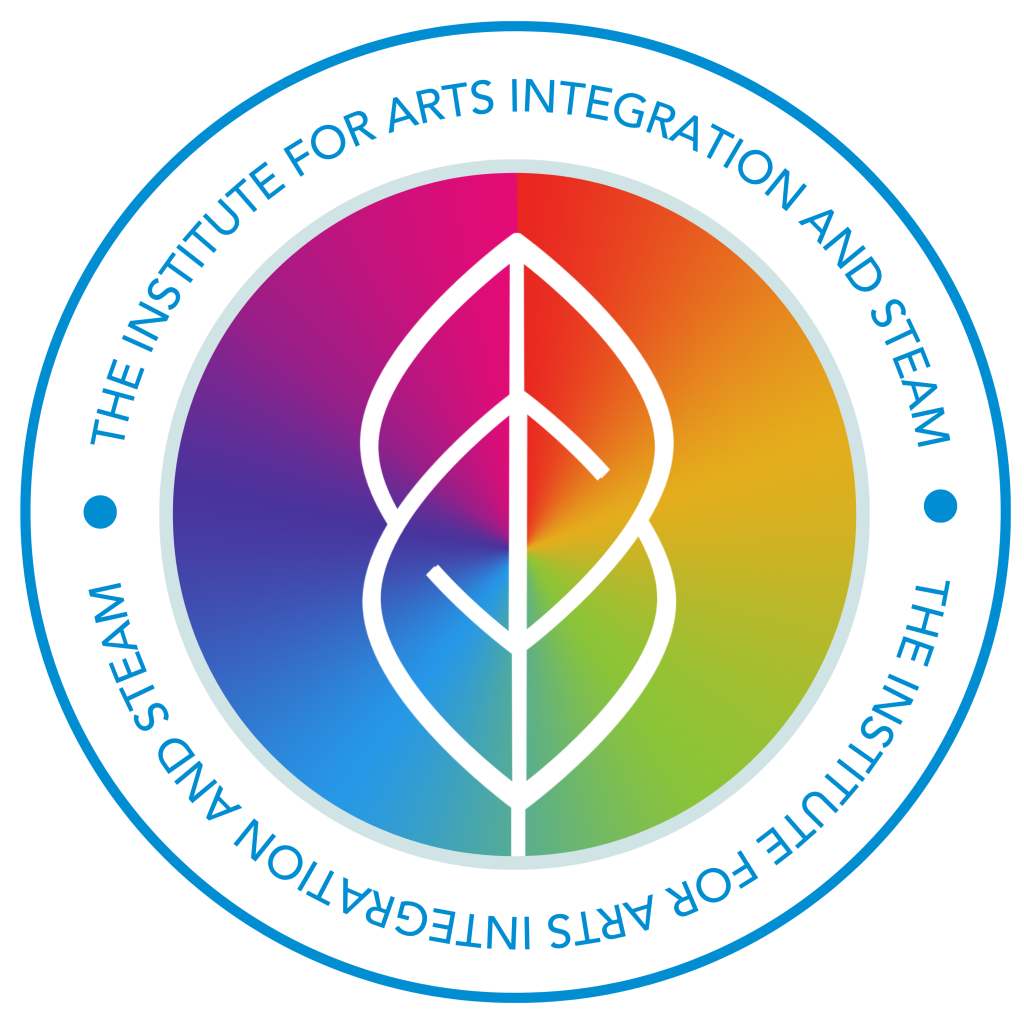ART WORKS FOR TEACHERS PODCAST | EPISODE 139 | 27:23 MIN
Curiosity: The Quiet Superpower
Too often, we treat feedback like a threat and creativity like a talent. But what if the real key to both is something far simpler… and more powerful? In this episode, Anne Jacoby reveals how practicing curiosity can transform the way we lead, teach, and learn. It's a mindset shift that will stay with you long after the episode ends.
Enjoy this free download of the Shifting from Criticism to Curiosity Resource.
Hi Anne, welcome to the show. I'm so excited you're here.
Anne
It's great to be here, Susan.
Susan
Wonderful, so we always like to start by getting to know our guests a little bit more. So can you share a little bit about your journey and what's brought you to the work you do around creativity?
Anne
Absolutely. So I have an unconventional background into business. I was a professional singer, actor, dancer, so was in that creative world and then made a big pivot to corporate life. joined a startup thinking that that would be more stable than performing and I ended up staying there for about 12 and a half years. It actually was very stable and grew that company from seven people to thousands around the world. It was really an exciting experience.
And that's really where I got this aha that creativity is essential in business building. So all of the stuff that I had learned in the arts field actually did translate and apply to the business world.
Susan
So talk to a little bit more about that because I think our audience would really love to know, especially because they're educators, oftentimes we get so into the world of education, but we know that we're preparing our students for careers. And we want to know like what's happening, why is creativity such a big deal in the workplace right now?
Anne
Yeah, I mean, I like to boil down creativity to the essential skill of problem solving, because when we are faced with problems and there are lots of them in the world and in business and in really any field, right, the medical field, there are lots of problems to solve. And when we apply creative thinking and we allow ourselves to believe that there's a better way, believe that we can improve, then all of a sudden all these opportunities open up and we start to see things differently and we start to collaborate better and have more fun doing it. So I think that creativity and that creative mindset really does start young. I have two kids in school, elementary school, fifth and second grade. So I see it day to day and I know how important that creative mindset can be.
Susan
So let's talk a little bit more about that creative mindset because sometimes I think people get creativity and the arts as in terms of an arts form, art skills, art applications, kind of intertwined. And I think that having a mindset around creativity helps us to distinguish maybe between them or put them together. So talk to me a little bit more about that.
Anne
Yeah, I face this a lot with my clients too. They say, I cannot draw. I am not creative, but you're right. They're, very different. And the application of creativity in the arts is great, but this is a skill that anyone can develop. every, everyone has the capacity to be creative. I really believe that it has to do with seeing things in a new light or seeking out perspectives, really practicing. Okay. I'm going to think differently about this. That's applied creativity. And so I think regardless of whether you have the skill and the talent of an artistic realm, it really doesn't matter. You can still exercise and develop your creativity in any form.
Susan
I love that because I see that all the time, especially when we're working with classroom teachers who are so scared to use any kind of arts medium. And I'm like, it's not about the medium, it's about the creative act, right? So how did your artistic background though influence perhaps, maybe not influence directly, but kind of give you perspective on the creative work that you do with others who maybe are not as artistic?
Anne
Yeah, yeah, I love this Dorothy Parker quote and I put it in my book that creativity is a wild mind and a disciplined eye. And I think about my roots in the arts and how I was able to imagine, I was able to dream big and really developed that muscle early on as a kid and also applied the discipline of specific art forms. In my case, singer, actor, dancer really focused on that discipline, but the same applies in any field where creating that discipline, creating that structure can actually facilitate creativity. It's almost counterintuitive. You think that creativity means it's loosey goosey and there are no rules when actually when you create those boundaries, more creativity can flow. So it's really an amazing practice and a discipline that I think teachers are in a unique position to develop with their students.
Susan
Yeah, and I also believe that, least in my background in the arts and in music, that the resilience that you build as a practicing artist is also something that can be crossed over into the mindset of creativity, the idea that it's not, it is fun, but it's also work. And it's also, you're also working with others and needing to figure out all of the nuances to that as well.
Anne
Yeah. And you think about how, you know, when you don't have to be perfect all the time. And I think there's a lot of kind of instinct that you have to get things perfect where in real life, we know that it's all trial and error, that you have to feel free enough to try new things. And that's so applicable in so many fields to facilitate success. know, success comes from lots of trial and error and lots of failing and learning from it. But you have to feel comfortable with that process, which I think is a very creative process in order to move through all those, those trial and error periods.
Susan
Yeah, absolutely. Now one thing that really struck me about your work is your perspective on feedback. That it's something that fuels creative growth rather than shutting it down. I found this really interesting because I struggle personally with feedback. I know it's something that I should want. I know logically that it makes me better. But to your previous point, it also highlights the fact that I'm not perfect.
And my type A persona doesn't like that. So talk to me a little bit more about this perspective on feedback as creative fuel.
Anne
Yeah, I'm so glad that you're focusing on this because it's a really vulnerable thing to receive feedback. And what I learned as a young performer is feedback is an essential process, part of the process of being creative. So I'll give you an example. Doing a run through in a play, you automatically come into the house seats and the director and the stage manager sit on the apron of the stage and they give notes. And that is a very public feedback process where even the most skilled actors and performers are getting notes about, you didn't hit this mark or that joke didn't land, or you were a little bit off key here. They've got to take the notes in order to create and co-create this work of art. And I think in observing that from a really young age, how people just take the note and they move on and they learn from it. And then next time they do better that it almost normalizes the process of, okay, I'm not gonna be perfect and I can always improve and I can always build on what I'm learning from my audience. And then all of a sudden we get into the workplace and it's this super emotional, highly charged, once a year experience for some of us, where if we just do it on a regular basis and normalize it, hey, I have a note for you, try this next time, or hey, I have a note for you, you really did a great job here, do more of that.
The more specific we can be in that feedback process and the more we can make it continuous and real time, the more that we de-stigmatize the scariness of feedback. It doesn't feel so high stakes and we just know that it's part of the creative journey. So that's kind of how I see the world of feedback.
Susan
I think that's so important. I think it's something that we need more of, even if we're uncomfortable with it. So I have a couple of kind of follow-up questions to this because I'm super interested in, I found your notes aspect to be really helpful because as artists, you're critiquing but it's never in a spiteful way. It's meant to enhance the art, right? That it's not about you as the artist, you're the vehicle to the art.
And so it doesn't become personal when there's feedback involved in our artistic aspect. But when we shift to work, whether that's as a teacher getting feedback from an administrator or from another teacher or in the business world where you're getting that evaluation once a year, it feels really personal or feedback. It can feel personal because we tie ourselves to the work that we're doing, right? So how can we leverage that creative aspect of focusing on feedback within the work. How can we use that for ourselves so that the feedback isn't personal? It's about what we're trying to do with the work that we're given.
Anne
Yeah, I love using curiosity as a tool in this framework. So, you know, if you're curious about someone, why did you make that choice? You know, and rather than being critical, overly critical about something, if we go to that curious, then all of a sudden it's, might have this wrong, but I'm curious about why you applied this technique, or I'm curious why you made that choice. All of a sudden you're right. It's less personal. It's about you know, giving the feedback receiver the power to change and that with a little curiosity, we can actually build and improve, and maybe have a better outcome next time. Same goes for the, feedback receiver. If I get a note and I'm, you know, hurt by it, I tried to encourage myself to get to the curious, like, Hmm, I wonder why that didn't land or I'm wonder, I wonder why that didn't have the effect that I hoped it would.
And then all of a sudden I'm kind of letting myself off the hook. I'm getting to that curious state. It really opens up more possibility for improving without feeling so wounded.
Susan
I think that's so important. It reminds me a lot of Ted Lasso. There's an episode in Ted Lasso where he talks about if people had been more curious about me, they would maybe ask questions that would help them understand why I'm here. And I think we oftentimes are so busy, right? We just want to give the note, move on, rather than dig in. And so I think part of what you're sharing, at least from my perspective, is to slow down, slow down with the feedback, slow down in thinking through the feedback and make it purposeful. Is that right?
Anne
Mm-hmm. Yeah, I think so. And also recognizing that in a lot of cases, they're just opinions, you and you kind of you start to look for patterns and, know, is this an outlier or is this really something that I can improve on and take it with a grain of salt? You know, take what works for you, internalize that, make adjustments and then move on. So I like your slowdown, but I think it's also putting it into perspective where, OK.
It didn't land with you, but it landed with all these other people. And so I'm going to continue to, to move through it that way.
Susan
Yeah, and I love that because you're people the empowerment to decide for themselves, the feedback that they'll ingest versus the ones that is like, okay, that's just something, that's a note and I can move forward from it. So you've described creativity as something that can be built over time, right? Not something that people are born with. So for educators that are trying to cultivate that mindset with students, or maybe even themselves. What are some ways that they can move the needle in that direction?
Anne
Yeah, I mean, I think, again, going to that specificity, you know, I think a lot of times educators, you know, might just say, good job. You know, it's hard to know what to do with just a good job rather than I really like the way you you tried so hard on this or you really focused on this and it had a good outcome. Maybe you were really descriptive in this story. So being specific, I think, really helps. And I think as educators giving a lot of different ways to apply learning, you know, I'll give you an example. when I was in fifth grade, I did a state report and my parents had kept a lot of my old schoolwork and I discovered it the other day. Well, my daughter's also in fifth grade doing a state report. And so I thought it was kind of fun to compare her state report with mine. And she just said, well, I just filled out the template that they gave me, you know, a slide template.
And it just felt so limited in a way rather than, have you thought about this? Have you thought about exploring, you know, a colorful map or other ways to express learning? And I think a lot of times we're so focused on kind of being at this page at this time of the year and, and you have kind of a playbook to follow rather than thinking, well, how else could this student apply the learning in a different way? Is it, you know, diary notes and you know, acting out a scene, you know, an experience, really getting a lot of different ways to bring to life the learning is a great way to apply creativity.
Susan
Yeah, and giving multiple avenues for different creative aspects. So theater or art or music or offering the opportunity to explore all of them, right? Yeah. So I know that in your work, you work with a lot of companies and leaders who are looking at creativity and connection for their teams.
And we've talked on this show quite a bit about culture and the importance of developing a positive school culture through relationship building and respect. I'm curious from your perspective on building a creative culture, what does that entail? So, because that sounds very ethereal. So can you give us some specifics on what would that entail and how would leaders best implement that in their building?
Anne
It does. Yeah, gosh, we could spend many, many hours talking about this, Susan. But I think the first element that I would focus on is creating a sense of safety. And that goes for peers. goes for teachers working with administrators, feeling safe to be vulnerable, feeling safe to ask questions, feeling safe to say, I'm wrestling with this challenge and I love your perspective on it, you know, the more that we can facilitate that kind of environment, think the creativity really does flow from that because it's very difficult to take a risk if you're worried about being judged or criticized or laughed at. so that safety is really the foundation for any kind of creative culture. and I think, you know, the other thing to think about is just, being able to learn from each other and gather those different perspectives.
So not making it so limited to, this is my experience and I need to be the expert at all things. It's really seeking out these different perspectives and using that as fuel to think differently about problems. those are kind of two practical ways that I would say you can build that creative culture.
Susan
I think that's important. And some of what your work focuses on from what I've been able to kind of dig into is the connection between creativity and belonging. And I think part of creating that culture is also creating a culture of belonging, right? Where you feel seen and valued. And so how does creativity directly support?
Anne
Yeah, mean, belonging is huge. There's so much research around the importance of belonging, how it leads to better outcomes and just better work satisfaction. So, you know, we're social animals. We want to feel like we're we're part of something bigger than ourselves. And I'd say for either school communities or workplace communities, really focusing on what are our shared values? What do we find alignment around? How do we live those values? What does it look like in action?
And then finding ways to reinforce that so that they're not just words on a page or, you know, written on the wall at school, but that we're actually living the values through stories and sharing examples so that it comes to life. So I do a lot of that kind of work with my clients in corporate settings, but the same apply to schools as well and educational environments. So how do we align, unite around a shared vision, a shared set of values in practice?
Susan
So let's dig into that a little bit more because I think that's important, especially when we're talking about various groups of stakeholders. So in schools, we're working with teachers, we're working with students, we're also working with parents and community members who may not all have the same set of shared values. So how do you navigate through that kind of conglaboration of like all of these, you know, groups?
Anne
Yeah, yeah, I mean, I think it's through conversation. It's through one conversation at a time. And these are relationships at all levels, like you pointed out all these different stakeholders in the same ecosystem ideally want the same outcome, but finding different forums to talk about it, whether it's coffee with the principal or you know, let's have a night when we can all get together and talk about these shared values. have a multicultural night where we come together and talk a lot about our school values. And, know, I think finding those different forums to celebrate who we are, what we bring, we're not always going to have the same set of principles, but at least we can create these forums to talk about it freely and safely. I think that's the first step.
Susan
I think that's wonderful. And sometimes so often overlooked, right? It's an easy way to get started, but something that we often overlook because who has time? But I think you gotta make the time. But speaking of time, when, let's say a teacher's listening to this or an administrator and they're like, I buy into the creativity is important. It's obviously going to be applied once students leave us from a school building. But I have the the time constraints of my curriculum, have structures that are in place that nobody else is gonna buy into this with me. How do I embed some of this in a practical way? What do you think?
Anne
Yeah, I mean, I think starting with the mindset as the educator can be little bursts of creativity. I call them creativity boosters. The New York Times happens to be running a really great creativity challenge where it's, I think it's five days of little creative exercises where you can think about creating a poem or doodling or daydreaming, something that doesn't take a lot of time, but really shifts the mindset to get into that creative mode and space.
And that can be applied in the classroom as well. It doesn't have to take a lot of time. But I think in order to help students move the needle where they are, it's really about making individual choices and stretching them to think beyond where are they today, wherever they are on their growth trajectory, how can I encourage them to take one step further, to dream and envision a little bit more? And so it's really about customizing the learning based on the student, where they are, and encouraging, hey, could you think about this a different way? can you try, again, writing this in a diary form, or really learning how to put this on its feet as a play? Or is something that stretches them, but meets them where they are? That's how I would approach it.
Susan
Yeah, that's key. think small is, again, as we're small to go fast, right? You want to go slow to go fast. You've got small little iterations that can lead to a lot of longer term benefit. Before we head out though, I know that you've written this book called Born to Create. an Amazon bestseller. Tell us about the book and what it's about, how you came up with it. Give us all the things.
Anne
Yeah, well, I, again, you know, I really wanted to apply the learning that I had from my arts background, but then 20 years in business and being an MBA, just how do we share these creative principles so that more people can get their hands on the techniques and tools? And so I structured it in three acts. One, first act is all about personal creativity. How do you, you know, get more creative as an individual? Then we move into creative leadership. How do you act as a creative leader in a some of those principles. And then the third act is all about this cultural creativity. How do you apply it in a bigger setting, whether that's a school or in an organization? So that's kind of how the book is structured. you know, really love sharing the stories of a lot of the creative leaders that I've had the great privilege of knowing and working with throughout my career. So I really like to shine the spotlight on them too.
Susan
That's fantastic. So I would love to know what's your favorite story? What's your favorite vignette from the book?
Anne
Well, the one that's probably most memorable that I've heard is my dad actually getting locked out of my New York City apartment and having to find a creative way to get back in without the keys in the middle of little Italy in New York City. So it's a really funny little story. It tends to stick with people. Just the image of my poor dad climbing up the side of the building. It's quite a visual.
Susan
I can only imagine. I'm thinking of my own dad trying to do that and I just, yeah, I would not even imagine.
Anne
Hey, you know, you gotta you gotta find a window in if the door is locked. So I think that applies to our lives as well.
Susan
Yeah, absolutely. So before we go, can you let us know where listeners can find you, follow your work, and get in touch?
Anne
Yeah, yeah, feel free to link in with me, just linkedin.com slash in slash and Jacobi. You could subscribe to my sub stack, which is and Jacobi dot sub stack or go to my website, which is Spring Street co.com.
Susan
Fantastic, and we will put all those links in today's show notes. Thank you, Ann, for joining us today and for bringing your creative light and inspiration to us so that we can learn how to bring that to our students. I really appreciate it.
Anne
Thank you, Susan. Thanks for having me.

